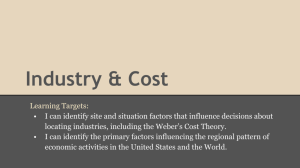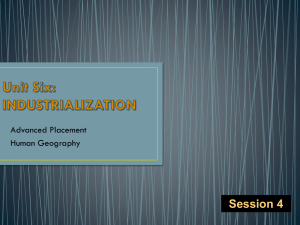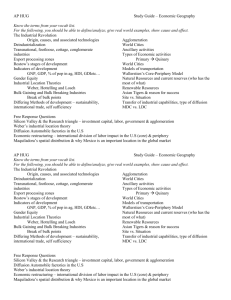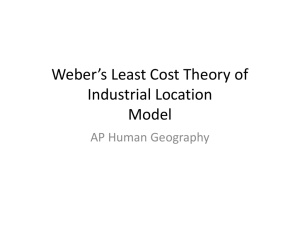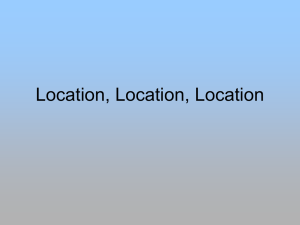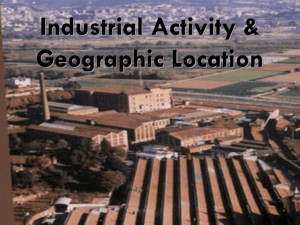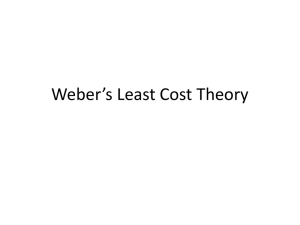Weber and Hotelling PPT
advertisement
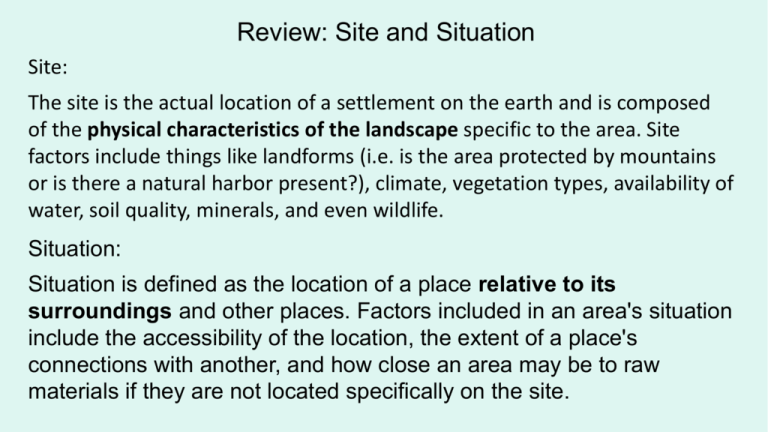
Review: Site and Situation Site: The site is the actual location of a settlement on the earth and is composed of the physical characteristics of the landscape specific to the area. Site factors include things like landforms (i.e. is the area protected by mountains or is there a natural harbor present?), climate, vegetation types, availability of water, soil quality, minerals, and even wildlife. Situation: Situation is defined as the location of a place relative to its surroundings and other places. Factors included in an area's situation include the accessibility of the location, the extent of a place's connections with another, and how close an area may be to raw materials if they are not located specifically on the site. Factors in Industrial Location (The “Why There?” of Industry): •Proximity to raw materials •Proximity to cheap and/or skilled labor •Proximity to transportation conduits (rivers, canals, rail lines, roads, ports, airports) •Proximity to markets/consumers for your product •Availability of cheap power (electricity, coal, etc..) •Availability of cheap land (factory has to go somewhere) •Availability of capital (still counts even in age of electronic banking) •Agglomeration advantages Which of these are “site” characteristic, and which are “situation” characteristics? Site: Any location factors at the potential site of a factory. The key site factors considered when chosing where to put a factory (industrial location) are: • • • • Land Labor Capital, and Agglomeration Advantages Situation: Any location factors related to transportation of materials into and from a factory. These are: • Proximity to inputs including raw materials and energy (coal, cheap electricity, etc.) • Proximity to markets Weber's Least Cost Theory • Weber's Least Cost Theory attempts to describe and predict the location of manufacturing industries based on three factors: transportation costs, labor cost, and the benefit of agglomeration (clustering with similar, interdependent businesses). • Of these, he considered transportation costs to be the dominant factor in determining where an industry would chose to locate. • Mnemonic device for Weber’s Least Cost Theory: Weber was TALL (Transportation, Agglomeration, LLabor (I actually have no idea if he was tall or not.) 1. Weber's Least Cost Theory is based on two site factors (labor and existence of similar industries in the vicinity (agglomeration) and one dominant situation factor: transportation costs. 2. Bulk-reducing industries such as steel or paper production in which the final product is easier to transport than the raw materials that go into their production will be located as near as possible to the raw materials (more expensive to transport inputs than the product). 3. Bulk-gaining industries, such as soft drink bottlers or automobiles in which the final product is more difficult to transport than the raw materials that go into their production will be located as near as possible to the customers (more expensive to transport the product than the inputs). 4. Weber realized that in some cases, savings from low cost labor or benefits from agglomeration (sharing skills, talents, and facilities with similar nearby industries) might convince an industry to locate farther from inputs or markets despite higher transportation costs. But in this model, transportation costs are the dominant factor in describing or predicting the location of manufacturing industries. Hotelling’s Model of Locational Interdependence (aka “why are gas stations and coffee shops always right next to each other?”) Model of the locational interdependence of industry developed by Harold Hotelling stressing that the location of industries can't be understood without reference to the location of other industries of like kind. Used ice cream vendor on beach example. Two ice cream vendors on the beach. What is the optimal location for each to optimize sales 1. Each vendor sets up so that their market shares are equal. 2. Vendor A realizes if he moves next to vendor B, he will sell to all of the customers to his left, capturing 75% of the market. 3. The next day, both vendors realize that setting up in the center of the beach is the only way of keeping the other vendor from “stealing” part of their market share.

